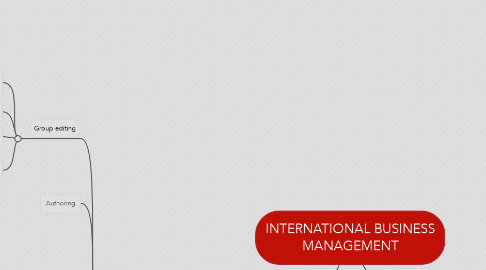
1. Benefits of adopting web tools 2.0
1.1. Group editing
1.1.1. Collaborate on a single, centraly stored work product
1.1.2. Free or inexpensive
1.1.3. Editing environments
1.1.3.1. Due to security and confidentiality
1.1.3.1.1. Lack in outside participation
1.1.4. Eureka system
1.1.4.1. They let outside community co-workers to participate in order to solve problems
1.2. Authoring
1.3. Generate content and putting it online for a broad audience
1.3.1. Goes fromsharing status updates in social networks to photos and blogs
1.3.2. Share knowledge, expertise and experience
1.3.3. Few barriers to knowledge sharing
1.3.4. No distortion in knowledge transfer
1.3.5. Employee engagement
1.3.6. Self-healing content
1.3.7. No excessive burden on administrators
1.4. Broadcast search
1.4.1. People publicize not what they know but what they don't know
1.5. Network formation and maintenance
1.5.1. Social software platforms are collections of information
1.6. Collective intelligence
1.6.1. Use of technologies to make prediction market and generate answers
1.7. Self organization
1.7.1. Users are able to built valuable communities and resources
2. Marketing meets Web 2.0
2.1. Our constantly changing world
2.1.1. More control of the internet.
2.1.2. The Web 2.0 opens a new window in marketing.
2.1.3. It was a new space for any company to exhibit their products.
2.2. Web 2.0, social media, and creative consumers.
2.2.1. WEB 2.0
2.2.1.1. A shift in locus of activity from the desktop to the Web
2.2.1.2. A shift in locus of value production from the firm to the consumer.
2.2.1.3. A shift in the locus of power away from the firm to the consumer.
2.2.2. Creative consumers
2.2.2.1. Creative consumers are the new locus of value in Web 2.0.
2.2.2.2. The media (e.g., YouTube, Facebook, Twitter) are essentially vehicles for carrying content.
2.2.3. Social Media
2.2.3.1. Comprise both the conduits and the content disseminated through interactions between individuals and organizations
2.2.3.2. Social media content comprises text, pictures, videos, and networks.
2.3. Power and value in the new dispensation
2.3.1. The new global marketing environment is littered with success and disaster stories for many well-known brands.
2.3.2. You can have success in the new Web 2.0, by advertising stuff or maybe showing your talent to the world.
2.3.3. The language is an important part, because you have to use a universal language like english.
2.3.4. It seems to be easy to make an new campaign in the web 2.0 but its not.
2.3.4.1. You have to follow 5 axions in order to do that.
2.3.4.2. You can do it in Facebook, Twitter, YouTube, all the social media is available for you.
2.4. Five axioms for using social media and creative consumers in international marketing strategy
2.4.1. 1. Social media is a function of the technology, culture, and government of a particular country.
2.4.2. 2. In the age of social media, local events seldom remain local.
2.4.3. 3. In the age of social media, general issues seldom remain general.
2.4.4. 4. The actions and creations of creative consumers tend to be a function of the technology, culture, and government of a particular country.
2.4.5. 5. Technology tends to be historically dependent; thatis,technologiesin different countries evolve along unique trajectories due to inertia rather than because they are the optimal solution.
2.5. Technology, creativity, and power
2.5.1. The attitude and language of engagement is one major barrier
2.5.2. The successful implementation of social media plans has to do with technology.
2.5.3. Bureaucracy is an impediment to the implementation of social media plans.
2.5.4. An obvious barrier to social media plan implementation is that employees lack IT and communication skills.
2.5.5. Many organizations are still oblivious to what has been termed the "digital divide".
2.5.6. Finally, it is still true that senior decision makers in some organizations see social media as the wasteful pastime of teenagers.

